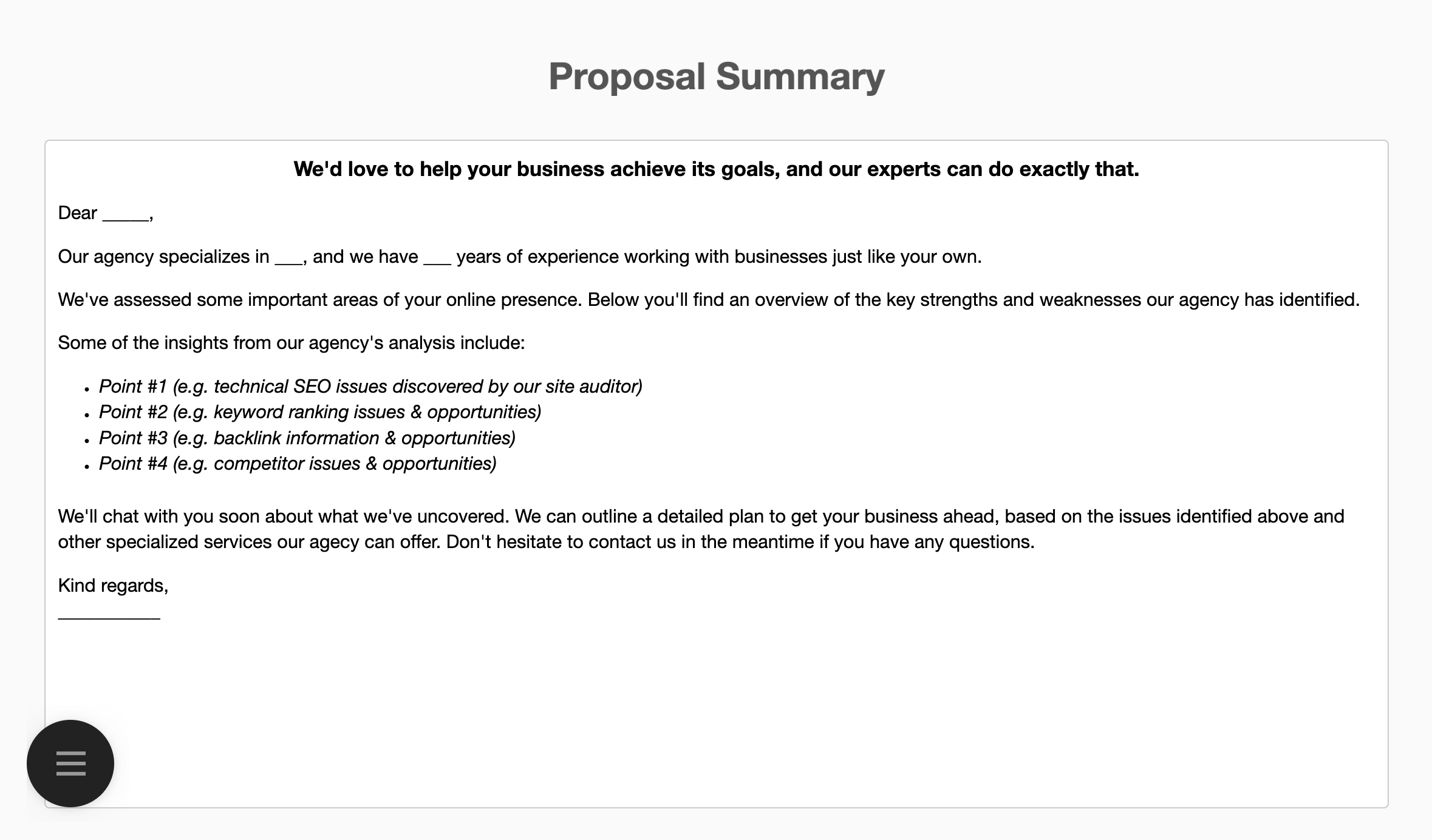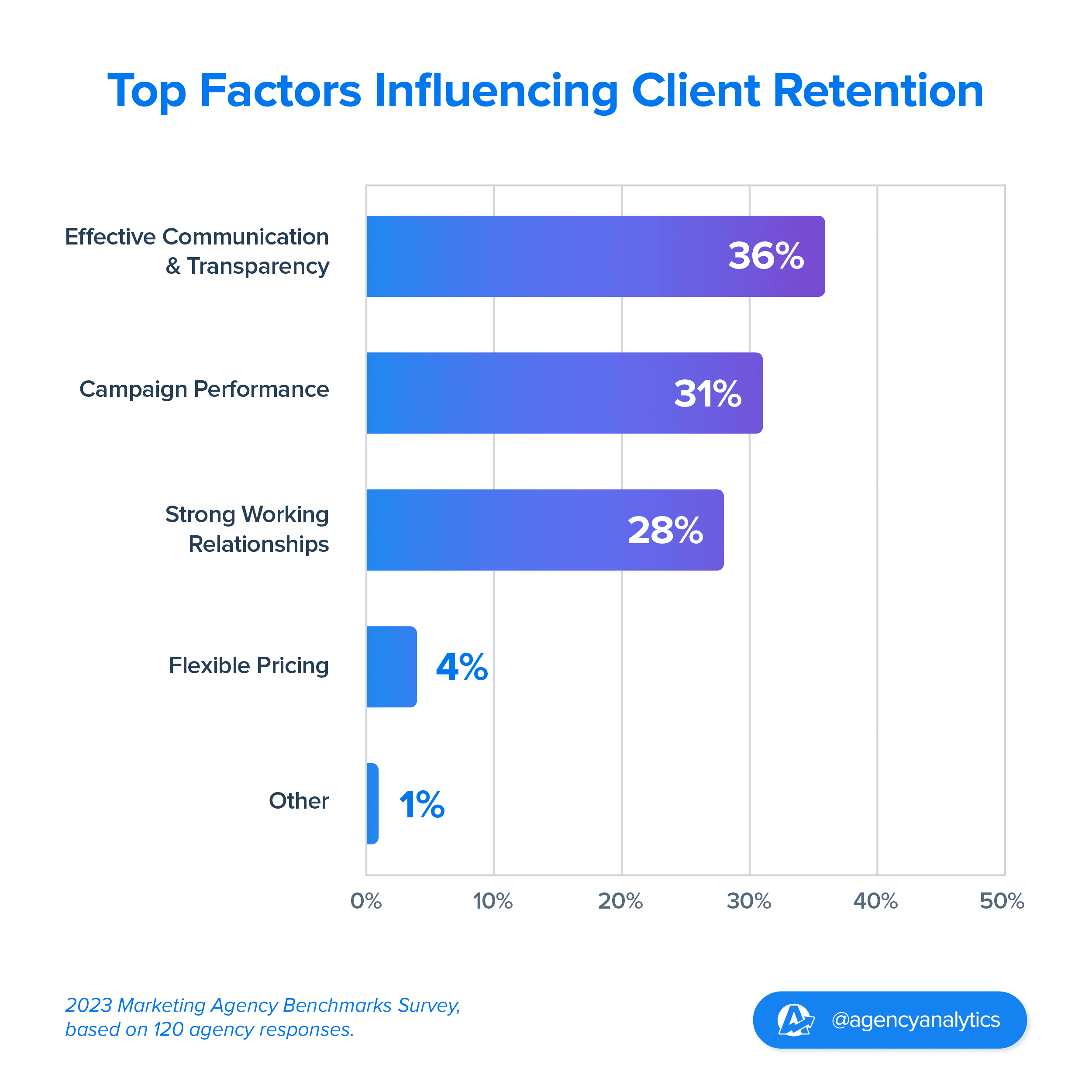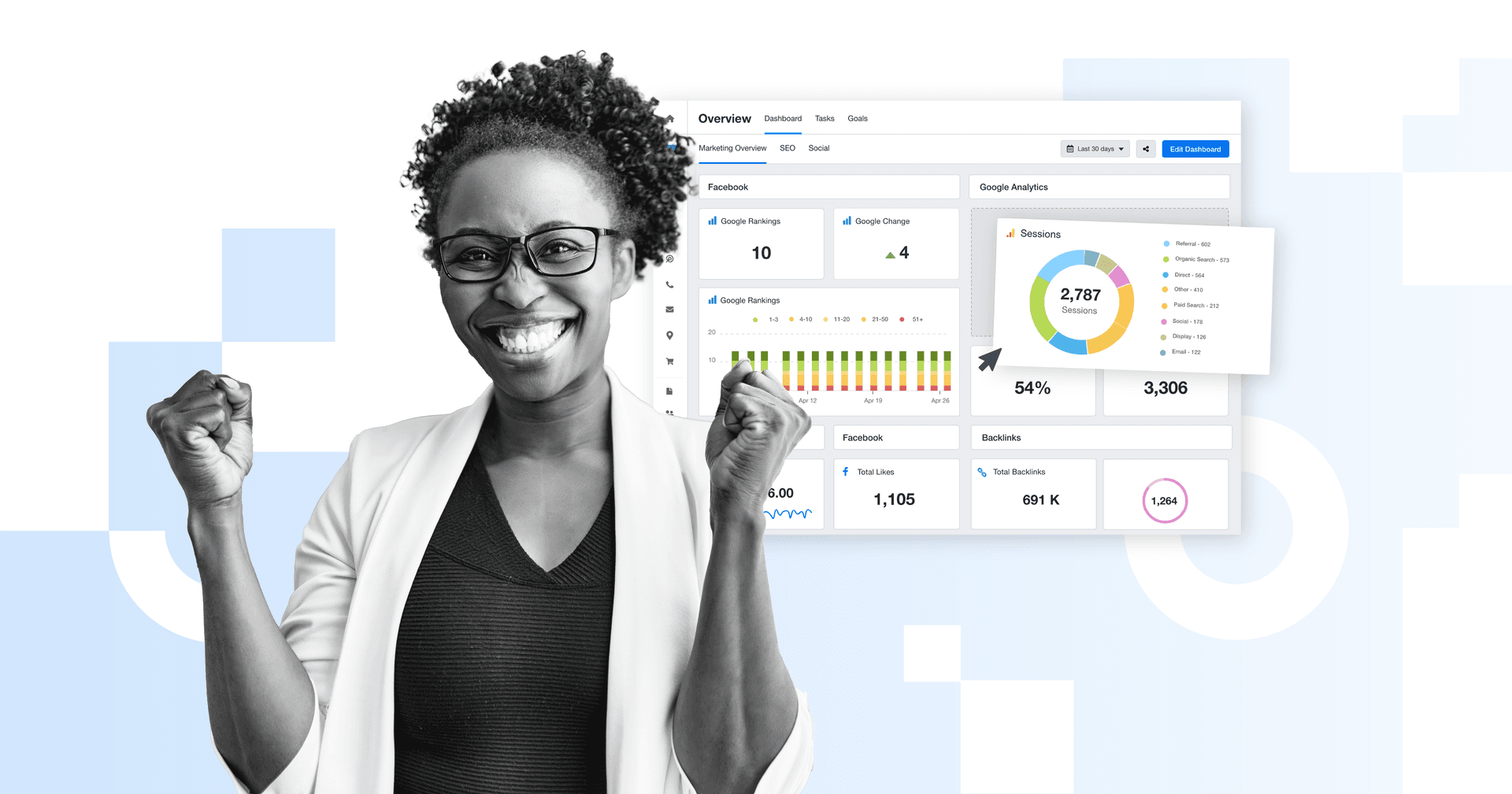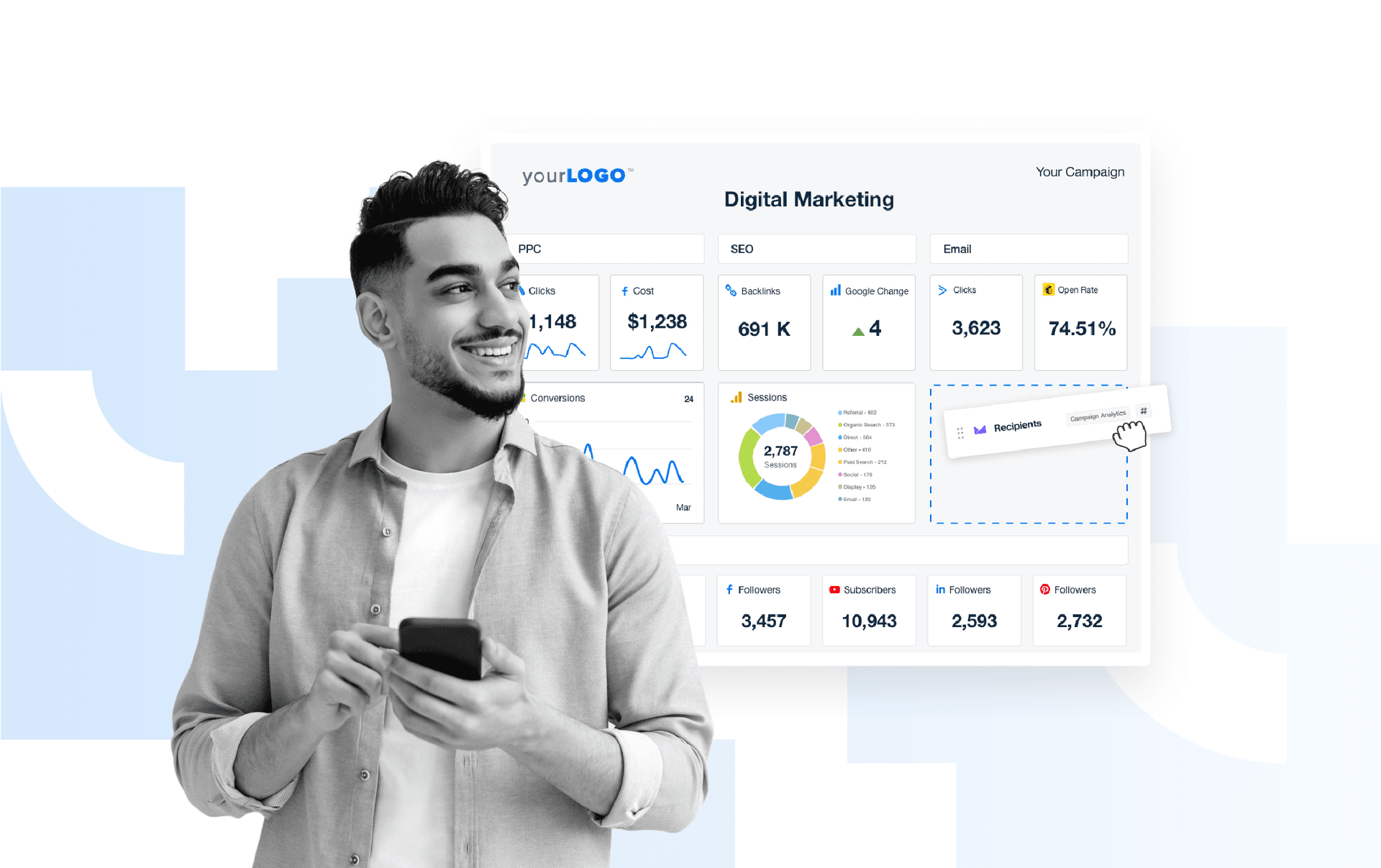Table of Contents
Your agency has met with the hot new prospect, completed discovery and presented your recommended marketing strategy. Now, they want to share your digital marketing proposal with additional team members and decide if they’re going to sign on as new clients.
Behind closed doors. Without you.
The future of this deal depends on whether you were able to craft a winning digital marketing proposal. One that acts as your best and hardest-working sales rep, establishing your credibility and value… even in your absence.
Have you included everything you need to?
Stress not. Today, we’re guiding you through the process of creating an irresistible digital marketing proposal, including the indispensable elements to convert new clients confidently, and at scale.
What Is a Digital Marketing Proposal?
Digital marketing agencies use digital marketing proposals to promote their services to potential clients. Your digital marketing proposal should briefly outline the client’s goals, the scope of work, and the strategy that will achieve those marketing objectives. It’s a comprehensive business proposal, summarizing how you will meet the client's needs and grow their business across channels.
As a high-level document designed to attract new business, it communicates your agency’s services, timeline, and pricing of the customized marketing plan, so the client has everything they need to decide if they want to sign a service contract with you. To demonstrate your aptitude and expertise, include examples of previous work and testimonials from prominent clients.
A digital marketing proposal could incorporate all relevant digital marketing services, including:
Search Engine Optimization (SEO)
Pay-per-Click Advertising (PPC)
Social Media Marketing
Website Design
Optimizing Your Digital Marketing Proposals in the Agency Sales Cycle
At what point in your sales process should you use a proposal? Should you employ it with every pitch? Could you streamline the process?
All important questions, so let’s get you some answers.
Because digital marketing proposals are so important to effective client acquisition, they are an indispensable part of the onboarding process. As a digital marketing company, creating a repeatable process using digital marketing proposal templates saves your staff from wasting valuable time and duplicating (quadruplicating?) the same basic pitch time and time again.
The first step to creating a compelling digital marketing proposal is to qualify and uncover client needs during a discovery session or briefing meeting. As a baseline, you need to understand their goals and expectations and determine if your agency is a good fit to be able to fulfill those needs. Some probing questions you can use during your conversation include asking about their:
Corporate and brand history, including mission, vision and values.
Popular products and services.
What problems they are currently facing, and how they tried to tackle them in the past.
What marketing strategies they’ve found to be the most successful and why.
Desired budget and timeline.
Your client’s answers are an early indicator of whether you’ll be able to satisfy their expectations and build a compatible working relationship. It’s also an opportunity for a light sales touch. Take a moment to mention relevant brands you’ve worked with and highlight some notable wins. You’ll get another touchpoint later on when you present your proposal.
The second step is to create your pitch: the digital marketing plan of action that summarizes your vision for the prospect and what you’re going to do to achieve their goals.
Lastly, use a pre-built digital marketing proposal template to streamline the process. Proposals, just like reporting, need to be high quality, repeatable, and scalable to help your agency grow. You want to quickly supply prospects with a well-crafted proposal that answers all of their questions and showcases your capabilities. Ensuring that it’s a comprehensive document that outlines your strategic plan tailored to their unique needs, aligned with their goals, and backed by data will increase your chances of closing the deal.
Confusion kills deals so we try to be very clear and remove anything that causes friction/confusion.
Derek Cosgrove, Sr. Account manager, seoplus+

The Most Effective Structure for a Digital Marketing Proposal
Now that we’ve covered the basics, we can dive into the bigger question: How should your agency write a digital marketing proposal?
We recommend a straightforward format with five main sections: An executive summary, problem explanation, project specification, client endorsements, and concluding with next steps and a punchy call to action. Below, we delve into what each section is composed of and why your agency needs to incorporate them into your client proposals.
Section One: Executive Summary
The introduction to a client proposal is a summary of all the points that will be discussed. It provides a high-level overview of the problem and goals uncovered during the discovery call, the proposed strategies you plan to implement, and some key deliverables, along with an estimated project timeline and budget.
Even though this is the first part of your proposal, it should be written last–after you’ve had time to gather together all of your data and determine your messaging. This portion needs to be punchy and impactful. You never know when a busy potential client may skip other parts of your proposal and simply skim the executive summary to get a feel for what you are offering.
Why Your Agency Needs It
The executive summary is there to serve as a strategic roadmap, providing an overview of your agency’s offering and potential benefits while clearing the runway for the detailed solutions to come.
If potential clients are getting pitches from multiple agencies, this is the time to spark their interest and set your company apart. Crafting an engaging introduction relies on including personal touches: individualizing your digital marketing proposal to resonate with their unique needs, highlighting your expertise to instill confidence, and addressing their most important pain points.
Demonstrating that you were a) listening during the briefing and b) how you plan to solve their problems, shows that you have a deep understanding of their business challenges and positions your agency as a frontrunner with a targeted solution.

Allow AgencyAnalytics to help you automate proposal generation and create compelling executive summaries that convert! Try it free for 14 days.
Section Two: Client Pain Points
This section takes a deeper dive into identifying the problem or pain points that your agency’s digital marketing strategies will address. It provides a detailed explanation of the issues, plus a breakdown of the target audience, desired outcomes, and any channels that will be included in the digital marketing campaign.
Why Your Agency Needs It
Everything else in your proposal relates back to this–the “why”. Business leaders are typically looking to marketing to fix a revenue shortfall. It’s up to you to determine the likely reasons behind this and frame monetary pain points as concrete goals or problem statements.
For example, when leveraging the findings of a low SEO site audit score, reframe the problem by focusing on the business goals, building context for your proposed solutions, and finally highlighting the value your agency will bring by resolving the challenge.
In this case, the client may not understand all the technicalities behind the poor score. But if you illustrate the impact of an improved audit score on the client’s online visibility and traffic, you establish your SEO expertise and drive value for your proposed solutions through tangible business outcomes.
Section Three: Project Specification
Once you’ve identified all the challenges you’re going to tackle, your project specification section is where you detail how you’ll solve them.
From all the available marketing options, provide a rough outline that summarizes your strategy, including deliverables for all of the tactics you plan to execute, the tools necessary to support implementation and key metrics you’ll use to determine campaign success. A timeline estimating how long each project phase will take, complete with significant milestones and deadlines, lets clients know how fast they can expect results.
This section may be further expanded to include a budget for the total projected cost of the digital marketing campaign, along with line items detailing expenses for each tactic. This supports price transparency and gives prospects greater flexibility in choosing the right mix of services to best fit their budget.
Always keep the client's goals in mind when preparing your proposal! If your client's goal is leads, be sure to mention how your proposed changes will generate more leads. I often see people create generic proposals that mention their agencies preferred metrics, and not the clients.
Joseph Blossman jr, Performance Marketing Manager, Morris Marketing Group and My 901 Media LLC
Why Your Agency Needs It
The solutions section persuades the reader that your proposed course of action is the best choice. In the previous site audit example, it serves as the link between what your agency offers and the results you drive for clients, like enhanced keyword rankings. It’s a bit of a balancing act to provide enough detail for prospects to make a purchasing decision, without overloading them with unnecessary details.
Section Four: Client Endorsements
One of the most convincing ways to demonstrate your agency’s skills, expertise, and stellar track record is by showcasing social proof from previous work. Including past wins and client references such as case studies, achievements, agency awards, and testimonials throughout your digital marketing proposal provides concrete evidence of your agency’s capabilities.
When choosing which case studies or testimonials to include, select examples in similar industries or with similar problem statements, showcasing how your strategies solved comparable difficulties. For example, giving the ol’ razzle-dazzle about fantastic results you achieved on various social media platforms doesn’t hold much water in an SEO client proposal. Selecting stories that resonate with a prospective client will reinforce their confidence in your ability to handle their specific needs and challenges.
If you’re an SEO agency, I HIGHLY recommend AgencyAnalytics. It contains the best reporting tool out there... by a mile.


Why Your Agency Needs It
When done well, this section becomes one of the most highly persuasive because it illustrates your successful delivery of projects for similar clients and the superior value provided. Incorporating case studies and testimonials builds up the credibility of your business and its methodologies, offering solid evidence of past achievements. This instills trust and confidence in potential clients that you can deliver the promised results.
Section Five: Next Steps and the Final Call to Action
Depending on how you choose to structure your digital marketing proposal, most agencies will include a final action-driven CTA, terms and conditions, and a signatory section for the client if they wish to move ahead.
Terms and conditions often encompass payment terms, cancellation notice, intellectual property transfer, confidentiality, data ownership, and more. And as always, it should be drafted by a qualified legal professional. Including all that legalese may feel like it has a dampening effect on the exciting proposal you put together, but it’s better to include everything upfront to streamline these last few steps.
Your call to action should navigate prospective clients through the final step you want them to take. At the end of the day, you want to leave your prospects with a sense of excitement, anticipation, and a strong desire to work with you.
Adding their main point of contact’s information in this section also ensures that if they have any last-minute questions, they know who to reach out to in order to expedite final contract tweaks or proposal adjustments.

Ready to take the next step towards streamlined, automated client reporting? Join more than 7,000 agency clients and try AgencyAnalytics free for 14 days.
Why Your Agency Needs It
The next steps and call to action (CTA) section of your proposal aren't just parting words–they're how your agency maintains momentum to close major deals. By explaining clearly what happens next and giving the prospect a reason to say yes, you're not just suggesting the next step; you're making it happen. This turns possible clients into real ones and proposals into exciting projects, helping your agency grow.
Best Practices for Writing a Digital Marketing Proposal
When crafting a digital marketing proposal, employing some simple best practices will significantly enhance your agency’s chances of success. Let’s take a look at some of the essential strategies to create winning pitches:
Showcase Return on Investment
The best way to convince a prospective client that you’re the right agency for the job is by focusing on ROI–and there’s a specific way you should present it in your proposal too.
Lead with the value your service will provide–if you can frame this as a projected dollar figure, even better. Then compare this larger figure to the much lower investment in your marketing agency’s fees. Positioning your costs as an investment rather than a ‘budget’ or ‘input cost’ evokes the idea that the client’s money will be positively returned in the near future.
This also highlights the long-term value that a strategic partnership with your agency will produce, shifting the perception away from this being a mere transactional exchange.
Highlight Your Agency’s Reporting Process
Outlining clear evaluation metrics and reporting processes in your project specification section informs clients how you measure the effectiveness of your proposed services. Detailing what metrics you’ll track to evaluate achieving customer goals, like website traffic, conversation rates or social media engagement provides a tangible way to assess value.
We use AgencyAnalytics as a key value point for our proposals, distinguishing our campaign reporting from competitors by showcasing the client-accessible dashboard and customizable nature of the monthly reports that we send.
Bill Dubiel, Digital Marketing Specialist, 19 Ideas
According to our AgencyAnalytics Marketing Agency Benchmarks Survey, the majority of agencies cite effective communication and transparency as the number one factor influencing client retention. Including a sample report preview and outlining your reporting process reassures clients that you’re committed to transparency and collaboration, and that they’ll be kept in the loop on marketing progress.

Outline how and when you conduct reports and check-in calls; or even better, offer access to a customized live reporting dashboard where clients will see their real-time project updates for maximum transparency. Test out the live reporting dashboard for yourself with a free 14-day free trial!
Don’t Rely on Email for Proposal Submissions
Instead of simply sending off your completed proposal via email and anxiously awaiting a response, consider a more proactive approach. Take the initiative to schedule a face-to-face presentation, either through a virtual meeting or in-person discussion. This way, you guarantee your proposal is not only received but also properly understood.
A meeting provides a valuable chance to establish rapport, quickly address any concerns, and tailor your message to resonate effectively with your audience. By choosing person-to-person communication, you’ll strengthen the impact of your proposal and increase the likelihood of a win.
Identifying When To Include a Clear Pricing Structure
Deciding whether or not to include pricing in a digital marketing proposal depends on the nature of your services, client expectations, and internal policy. There are pros and cons to each option.
The benefit of including a clear pricing structure is that it provides transparency and clarity. Clients appreciate it because it provides them with a straightforward understanding of the cost breakdown of your services–often a critical element in their decision-making process. It also shows that you are confident in your value proposition, reinforcing your services’ perceived worth.
On the other hand, there may be a strategic advantage in waiting to have a pricing discussion until after you’ve submitted your digital marketing proposal. This approach allows you to have a separate conversation to negotiate pricing, especially valuable in a situation where you may need to build out a more elaborate sales case when service value is challenging to quantify or when you need additional time to tailor your quote to the client’s needs and budget.
White Label Your Proposals and Reports
Make all of your reports, dashboards, and proposals your own by branding your client acquisition efforts with your agency’s logo and colors.
Bring together all the data sources for your digital marketing proposal into a single location to create consistency and cultivate the highest professional image—conveying how every aspect of your work is meticulously tailored to clients, for a clean and polished presentation.
Take advantage of a full suite of white label features that enable you to send reports from your agency's email and use custom domains to create shareable dashboard URLs for enhanced personalization.

Use the power of white labeling to make your templates look like they were built in-house. Try AgencyAnalytics free for 14 days!
Streamline Proposal Sign Off
You're already halfway through the digital transformation of your client onboarding process. So why not seal the deal by leveraging tools that enable next steps completely electronically? Whether it's capturing digital signatures on contracts or integrating with a payment platform for hassle-free transactions, there are plenty of tools that make signing off on your digital marketing proposal smooth sailing for clients. Electronic signatures are 80% faster and significantly cheaper than printing, mailing, and filing paper forms.
Conclusion and Key Takeaways
We’ve covered a lot of ground in this article, walking you through writing an example digital marketing proposal based on our report structure, and illuminating the key best practices to keep in mind.
In the end, an effective client proposal strives to balance showcasing your expertise and the unique value your agency brings, with client needs. The proposal stage offers a rare opportunity to both sell your services and establish a partnership based on trust and a mutual vision of success.
Ready to take your digital marketing proposals to the next level? Streamline your client acquisition process with AgencyAnalytics. Craft compelling pitches that strike a chord with prospects, and use the reporting solution to:
Optimize your proposal creation process for faster, consistent reports.
Convey your agency’s value through a combination of data, strategy, and client references.
Focus on ROI to drive home the benefits of investing in marketing.
Make sure you seize the chance to improve your proposal development process and secure additional high-value contracts. Get started with a free AgencyAnalytics trial today!

Written by
Lia Van Baalen is a Canadian content marketer with a decade of experience writing B2B content for SaaS, manufacturing and renewable energy companies. In her opinion, nothing is quite so satisfying in marketing as a good subject matter interview.
Read more posts by Lia Van BaalenSee how 7,000+ marketing agencies help clients win
Free 14-day trial. No credit card required.






